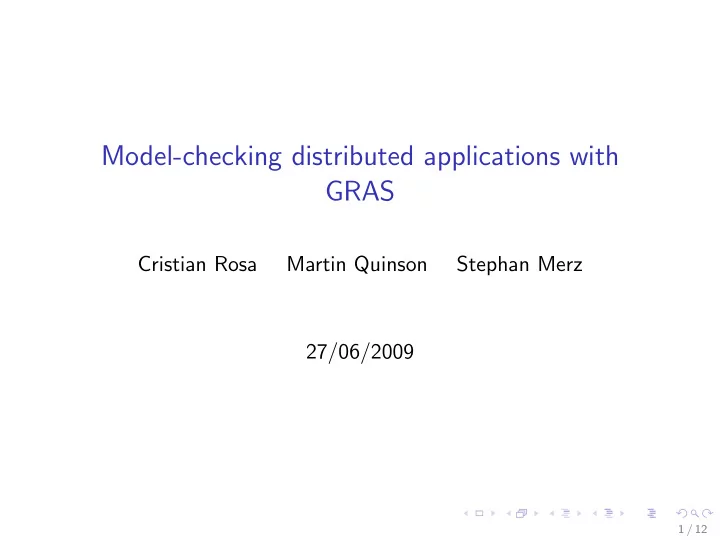

Model-checking distributed applications with GRAS Cristian Rosa Martin Quinson Stephan Merz 27/06/2009 1 / 12
Table of Contents Introduction Main Issues to Solve Prototype Related Work Work Plan 2 / 12
Introduction Developing Distributed Systems (DS) is challenging because: ◮ Lack of a global view of the state ◮ Asynchrony SimGrid is a framework for the simulation of DS It’s development is a common effort of different teams It provides: ◮ Simulation by real execution of the program (C and Java) ◮ Controlled execution environment ◮ Several APIs for developing DS (ex. MPI) SimGrid also provides testing capabilities, but it is not enough. Simulation is deterministic and conditions the scenarios. 3 / 12
Introduction Model-checking can provide: ◮ a more exhaustive exploration of the state space ◮ counter examples on errors Model-checking and Simulation has a lot in common, both need: ◮ simulation of the environment (processes, network, messages) ◮ control over the scheduling of the processes ◮ interception of the communication We decided to add an explicit state software model-checker to SimGrid 4 / 12
SimGrid Layout SMPI GRAS SimDag MSG GRAS in real world SMURF SimIX network proxy SimIX "POSIX−like" API on a virtual platform SURF virtual platform simulator XBT Figure: SimGrid Layout 5 / 12
Identifying Transitions ◮ General C programs model-checking is difficult ◮ Mainly because their semantics are not given in terms of LTS ◮ In DS the address space of the processes are isolated ◮ Processes interact by message interchange ◮ We focus on protocol verification for DS ◮ We consider as transitions only the send/receive actions 6 / 12
Transitions and Scheduling Internal operation of SimGrid: ◮ one thread per simulated process ◮ a maestro thread that decides the scheduling ◮ synchronous execution model ◮ each communicating action yields control back to maestro 7 / 12
Exploring the State Space The state exploration is performed using a depth-first search Back tracking is necessary to take different execution paths We considered two approaches: ◮ re-execution from initial state ◮ threads’ checkpoint mechanism We decided to implement a checkpoint mechanism Save and Restore capabilities are achieved by: ◮ intercepting all memory allocation functions ◮ using a special sanitized dynamic memory manager ◮ Saving/Restoring the heap, stack and data segments 8 / 12
Prototype We developed a prototype that is able to check toy examples ◮ verifies simple unmodified C GRAS programs ◮ checks safety properties limited by C scoping rules ◮ properties are expressed as C boolean functions (assertions) ◮ simple state saving/restoring mechanism ◮ simple depth-first search exploration 9 / 12
Related Work ◮ MaceMC is a model-checker for the Mace language ◮ DSL for developing Distributed Systems ◮ Describes the system as a reactive state transition system ◮ Source-to-Source compiler ◮ CMC general C/C++ program model-checker ◮ Explicit-state model-checker ◮ Safety properties verification ◮ ISP model-checker, University of Utah ◮ Verification of unmodified MPI C programs ◮ Safety properties verification 10 / 12
Work plan Current Work ◮ isolate address spaces of simulated processes ◮ define a memory region for the network ◮ add support for the rest of the SimGrid APIs Future Work ◮ exploit heap symmetries (heap canonicalization) ◮ implement partial order reductions ◮ add support for LTL properties verification and at a very long term... ◮ experiment with out-of-core memory ◮ distribution of the model-checking process itself 11 / 12
Thank You! 12 / 12
Recommend
More recommend